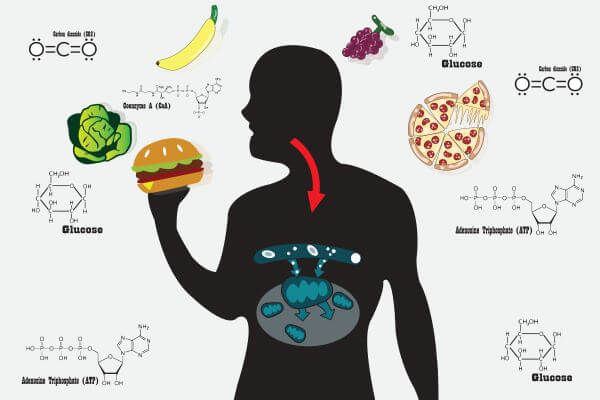In other words metabolic processes are important in extracting chemical energy from food. Catabolic reactions release heat as well as energy in the form of ATP.

Cellular Respiration An Overview Sciencedirect Topics
Gas that is released into the air as a by-product of.
. The release of aminotransferases from lactococci by autolysis could result in accumulation of. A high level of blood alcohol caused by reactions in the small intestine that use carbohydrates to produce alcohol causes ______ syndrome. Catabolism is the part of the metabolic process that breaks down large complicated molecules into smaller ones in order to produce energy.
A gas released as a metabolic product of catabolism Atrioventricular AV Node Specialized conductive tissue at the base of the wall between the two upper heart chambers. During cellular respiration oxygen aids in the catabolic breakdown of carbon compounds like carbohydrates. Among the products of this catabolism are CO 2 and ATP.
The combination of all reactions catabolic anabolic within a cell is termed _____. Oxidative phosphorilation by the catabolism ofcarbohydrates produces a lot of CO2 which must exit the lungs ingas exchange. One of two upper chambers of the heart capillary Smallest blood vessel.
Catabolism consists of the breakdown of complex molecules into smaller units to produce energy or to be used in anabolic reactions Removal or exchange of functional groups Involves transamination deamination and decarboxylation Releases excess nitrogen in the form of ammonium NH4 which then enters the urea cycle is converted into urea. This indicates that one pathway of lactate metabolism is respiration. Deoxygenated blood Blood that is oxygen-poor diastole Relaxation phase of the heartbeat.
Involves the complete catabolism and oxidation of the starting organic molecule to carbon dioxide -this could include glycolysis or some other series of reactions and citric acid cycle to get to carbon dioxide. Catabolism is a destructive process. This catabolism also has an important role in producing energy.
The results suggest that the direct precursor of methanethiol is 4-methylthiol-2-oxobutyric acid. The energy is released as a result of the destructive branch of metabolism. In addition some eukaryotes perform catabolic processes without oxygen.
The by-product of photosynthesis is oxygen required by some cells to carry out cellular respiration. You just studied 40. This process is referred to as catabolism and such reactions are associated with a release of energy.
The process involves the breakdown of large molecules such as polysaccharides lipids nucleic acids and proteins into smaller. 3rd stage of glucose catabolism hydrogens from glycolysis and krebs cycle are used to produce many ATP but are then. There are metabolic reactions that involve the breaking down of complex chemicals into simpler ones such as the breakdown of large macromolecules.
Aka citric acid cycle 2nd step in glucose catabolism where pyruvic acid is catabolized into by product of carbon dioxide some ATP is produced with temporary or intermediate energy storage molecules. Both 5α- and 5β-DHT then undergo 3α-reduction by the 3α-HSD enzymes to form 3α5α-androstanediol also. In addition to glutamate formation indicating cellular respiration of lactate R3230Ac cells were treated with increasing concentrations of lactate -glucose in vitro and oxygen consumption rate was measured.
Glutamate is a TCA cycle by-product formed from α-ketoglutarate. 3 Regulation Metabolic pathways Direct control - Quickest way to regulate Competitive - bind active site Noncompetitive - DO NOT bind active site Genetic control - Slower because switch is mediated by accumulation or production of product Induction Repression Factors that Affect Enzyme Temperature pH Osmotic pressure Denaturation. Carbon dioxide is the main waste product of cellular respiration or catabolism.
This means one chemical compound is converted into its end product of the pathway through a series of biochemical. Most CO2 from catabolism is released during A oxidative phosphorylation. Gas chromatography was utilized to determine if the products of methionine catabolism in the aminotransferase pathway were precursors of methanethiol.
Coronary arteries Blood vessels that branch from the aorta and carry oxygen-rich blood to the heart muscle. The primary site of catabolism of circulating testosterone and 5α-DHT is the liver130 Testosterone and 5α-DHT are taken up in the liver and testosterone is converted to an inactive metabolite 5β-DHT by the enzyme 5β-reductase. 3 Regulation Metabolic pathways Direct control - Quickest way to regulate Competitive - bind active site Non-competitive - DO NOT bind active site Genetic control - Slower because switch is mediated by accumulation or production of product Induction Repression Conserved Patterns in Metabolism - Linear - Cyclic.
Metabolism takes place through metabolic pathways. The difference between anabolism and catabolism can be seen from the following points. Carbon dioxide A gas released as a metabolic product of catabolism.
Thus these reactions are considered as exergonic processes. In stage II of catabolism the metabolic pathway known as glycolysis converts glucose into two molecules of pyruvate a three-carbon compound with three carbon atoms with the corresponding production of adenosine triphosphate ATP. The three intermediate products derived from BCAA catabolism ie succinyl CoA acetyl CoA and acetoacetate directly enter the pathways of intermediary metabolism resulting either in the synthesis of glucose gluconeogenesis or in the production of adenosine triphosphate ATP through their oxidation by the citric acid cycle 11.


0 Comments